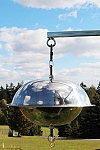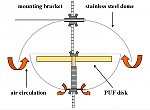Passive air sampling
Passive air samplers with polyurethane foam (PUF) sorbents are suitable for the monitoring of selected persistent organic pollutants (POPs). The sampling occurs through spontaneous diffusion of the analyte to the sorbent media – PUF. POPs are sampled as air naturally diffuses into the sampler housing and around the PUF, which then sorbs the target compounds. Subsequently, POPs are then analyzed in the PUF. One of the main characteristics of passive air samplers is their low sensitivity to sudden episodic fluctuations in pollutant concentrations. Rather, PAS are useful to provide information on the long-term average air pollution levels. The practical benefits of passive air sampling include low costs of equipment and operations (e.g. PAS do not require the presence of a technician nor power supply), low noise, and a low installation and maintenance footprint.
A passive sampler consists of two stainless steel bowls, one with a diameter of 30 cm and the other of 24 cm. The bowls are fixed on a joint axis, which also supports the PUF disk. All parts of the sampler housing are made of stainless steel. Passive samplers are hung at a typical human breathing height, that is, 1.5 to 2.0 m above ground. The Optimum installation position is in open area without significant obstacles in order to allow for the free flow of air around the sampler. Air samplers and their PUF disks are collected after 28-day exposure periods.
 |
 |

